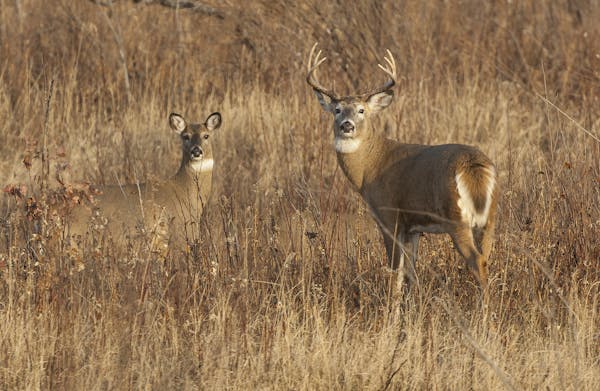Mark Thone was up early the other morning, drinking a cup of steaming tea, flipping through photos on his iPhone and trying to decide which of the pictured marshes would best suit his purposes.
He had a camera at the ready, and shortly thereafter slipped into camouflage gear, having narrowed his focus to one marsh where he thought the lighting would be good. Thone takes a lot of photos but he isn't a professional photographer, and he loves hunting for waterfowl, but flinging steel shot toward a bird wasn't on his agenda that morning. Thone's foray into the marsh was a revealing look at what it means to be a wildlife artist.
"You're not just sitting there on a couch when all of the sudden a divine vision hits you and you paint a masterpiece and it sells for a million dollars," said Thone, 52, of Shakopee. "Maybe that's happened to other artists, but not me."
Not that Thone, who recently won Minnesota's state duck stamp contest for the first time with his white-winged scoter painting, is complaining. A professional artist since 1998, Thone in recent years has become more active in entering wildlife contests in a number of states, having won or placed high in competitions in places such as California, Connecticut, Delaware, Minnesota and Nevada. He enters about six state stamp contests each year. Winning artwork is featured on the stamps, which, depending on the state, hunters must buy in order to pursue species such as ducks, pheasants and wild turkeys. Stamp proceeds are used for the management of those species.
Working with Bud Grant
A painting in 2002 of redhead ducks called "Five in the Corner Pocket," which was the 35th anniversary print of the Minnesota Waterfowl Association, boosted his art career. In 2006 he collaborated with former Vikings coach Bud Grant on a painting called "Bud's Minnesota Haven" for the 25th anniversary of Turn In Poachers, a group that encourages the public to report poaching.
Thone's wife, Christine, convinced him to have "Five in the Corner Pocket" framed, and it was the man at the Shakopee framing shop — John Schroers, a well-known conservation advocate and waterfowl hunter — who was instrumental in putting Thone's painting on the waterfowl group's radar. The painting shows five redheads, their wings cupped, beneath a mostly gloomy sky. If Thone closes his eyes and thinks about it, he can picture himself sitting in the duck blind, watching those birds wing across a lake near Glenwood in western Minnesota where his family used to hunt.
Almost all of his paintings are inspired by personal experience, he said. "It loses something if it doesn't come from there."
Which brings us back to the marsh.
Sometimes, Thone visits them for inspiration. Other times, he's out there snapping pictures — often with a digital camera and his iPhone, since they capture colors differently — and building up reference material for future paintings, or watching how birds behave. And on still more occasions, there's something specific he needs and he sets out for the marsh in search of it. Several years ago, for example, he was working on a painting of a northern pintail duck for the Minnesota stamp contest. He loved the way most of the painting looked, but wanted to add a muskrat house to it.
"I needed a muskrat house, and it was getting down there," Thone said. "I thought I would be able to find one around [Shakopee], so I went looking around. I found out there aren't as many muskrat houses around here as there are in western Minnesota."
He finished in fourth place in that contest, and believes his inability to create a realistic-looking muskrat house likely pulled him down. That said, the line between abstract and realistic art is one Thone's constantly considering. The sky he paints may not have looked exactly the way the sky looked on the day that inspired the painting. Or the ducks he paints in a fall piece may be displaying their brilliant spring breeding plumage rather than their drab fall colors. It's a judgment call when it comes to figuring out how far to stretch reality.
"You have to be abstract and you have to blur things out in certain areas; you don't want your eye to focus in on every stick and every detail throughout a painting," Thone said. "It's not total reality. [In many paintings] the sun is behind a bird. But if you're out there in the real outdoors and the sun is on the other side of the bird, that duck is going to appear very dark. So the lighting may not be totally realistic. You just have to adjust things so it looks better."
When he's in the midst of a painting, Thone's been known to clutter the house. He'll pull details from photos and use taxidermied animals to make sure his acrylic depiction is accurate. He's got bags of leaves that help him get the color just right, and he'll sketch animals on random sheets of paper whenever the mood strikes him.
"My wife's pretty cool with all the weirdness I bring into the house," Thone said.
But for Thone, the weirdness is a necessity.
"You generally don't just sit down and say, 'I'm going to paint a wonderful duck or pheasant stamp piece,' " he said. "It takes a lot of research."
Thrill of competition
Thone already is thinking about the competitions he wants to enter next year. Many contests require artists to paint a particular species of duck, which is a big factor in Thone's decision to enter or not. After all, nobody will know if the sky or water that appears in a painting is from California or Minnesota or Connecticut, but it's hard to fake being intimately familiar with a specific duck.
"If there's an Alaska sea duck, for example, my heart may say I want to enter that contest because that to me sounds really cool," Thone said. "So that's where I have to step back and focus instead on species that come through Minnesota a little more."
Thone loves the thrill of competition, but at the end of the day he's still the owner of a small business and has to balance the effort it takes to create a painting with the likelihood it will provide a return. (Some states provide financial rewards for winning their art contests, but many, including Minnesota, do not. In Minnesota, for example, artists retain the right to reproduce their work as prints.) On average, it takes him 60 hours to paint a stamp entry.
"It isn't uncommon to paint for 12 or more hours a day when there is a deadline," Thone said. "I've painted for 22 out of 24 hours a couple of times."
And once he sends off his stamp entry, Thone is well aware his fate is in the hands of a judge who may or may not react to the painting the way he intended. While having his artwork judged can be a nerve-racking thing, Thone knows he's got it pretty good.
That's what he was thinking the other morning, when others sat behind their desks, plugging away inside, while he pulled on a pair of chest waders and plodded along the perimeter of a marsh.
"This certainly isn't a bad place to have part of my office," he said.
Joe Albert is a freelance writer from Bloomington. Reach him at writerjoealbert@gmail.com.

Live: Twins, White Sox back in action; follow on Gameview
Wolves' Reid wins NBA's Sixth Man of the Year award

Scoggins: Worried about costly trade up in draft for QB? Vikings bosses shouldn't be.

